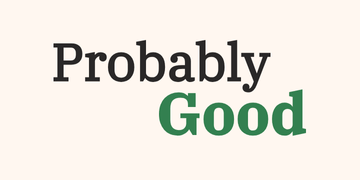Counterfactual impact is the difference you make by doing something versus what would have happened if you hadn’t done it. For example, if you help someone in need but simply replace someone else who would have done the same, your counterfactual impact is minimal because the person would have received help regardless.
Considering indirect outcomes
When deciding what to do, we often think about the direct outcomes of our actions. But when estimating the counterfactual impact of an action, we need to think about both the outcomes of the action and the outcomes of not performing that action.
Imagine, for example, you decide to volunteer in a soup kitchen that serves dozens of people. In some sense, it’s reasonable to say that you helped feed dozens of people. But let’s say you applied to volunteer at the soup kitchen alongside twenty other applicants and were arbitrarily chosen for this year’s position. If you hadn’t decided to volunteer, it’s likely that the same number of people would have been fed. In this case, your counterfactual impact—the difference between the outcomes of this action and the outcomes of what would have happened otherwise—may be nothing at all.
What if you didn’t take the job?
Let’s say you’ve made the exciting decision to use your career to improve the world. With a deep interest in biological and life sciences, you think becoming a doctor might be the best path. You’re confident that you have all the right skills to thrive – plus, you will get to directly help others in a tangible way, saving lives and improving people’s well-being. All this sounds great, but then you come across some troubling statistics…
Despite the shortage of physicians in the U.S. (where you’d be applying to schools), there’s a large gap between the number of medical school graduates and training residencies. This leaves thousands of graduates without a clear path to become a doctor. The low number of applicants accepted to medical school is another bottleneck, making it an extremely competitive field.
Realizing this, you start to question your ability to make an impact. If you don’t apply, will some other qualified applicant become a doctor in your place? Would you being a doctor make any difference in the world? Or would that other, next best candidate, do just as much (or nearly as much) good as you could?
Soon, you find yourself down a rabbit hole of counterfactual considerations. If someone else would take your place, it seems you wouldn’t make much of a difference at all. And if this is true for medicine, could it be true for several fields? Can anyone actually make a difference in the world that wouldn’t have happened regardless?!
Fortunately, it’s probably not as bad as it might seem. It’s true that only looking at direct impact can be misleading – if you neglect to ask, ‘what if someone else would have become a doctor in my place?’ you’re likely to overestimate your potential impact. This is because that replacement doctor might save or improve just as many lives as you would have – meaning it’s possible that no net difference is made in the world.
On the other hand, you’re likely to underestimate your impact if you only look at the difference between you and the hypothetical next best person to take your place, what we’ll call your “replacement impact.” This is because you’d neglect to ask, ‘what would that person do instead if they didn’t take my place?’ Maybe they would go on to do great things in a different job or field. This means that you taking the job actually enabled someone else to make a bigger impact.
Opportunity cost
Another important concept that relates to counterfactual considerations is opportunity cost. Whenever you spend a resource (such as money or time), your opportunity cost is the value of what you could alternatively have spent that resource on. Imagine, for example, that you found a charity that raises a million dollars and uses it to provide medication that saves 10 lives.
At face value, this seems obviously good. But imagine that, because of your excellent fundraising pitch, donors gave your charity this money instead of an extremely effective charity that could have saved hundreds of lives with that same money. In this hypothetical case, what can be seen as doing good directly could actually end up doing more harm than good if we consider the opportunity costs (or the counterfactual use of the resources you use).
Estimating counterfactual impact
Counterfactual considerations don’t always reduce our impact; sometimes they can significantly increase it.
One classic example of this is donation matching. If some organization or person is willing to donate a dollar for every dollar we donate to a cause, then by paying some amount of money (and helping to some extent directly), our actions actually provide twice the benefit counterfactually. Of course, to truly understand whether we’re doubling our counterfactual impact we need to know what the matcher would do with the money if we didn’t donate, whether others would likely take up the donation matching instead of us, and other similar questions.
As can be seen from the simple examples we’ve given, estimating counterfactual impact is challenging. In our own lives, and especially when considering speculative questions like the counterfactual impact of future career paths, we will usually not be able to estimate the full counterfactual impact of our decisions reliably. However, taking into account counterfactual considerations where these are clear and significant can still help us make better career decisions—or at least avoid some common pitfalls.
How to think about all this
Thinking about counterfactual scenarios for too long can get a bit dizzying. To put it all together, let’s think back to our previous hypothetical example of becoming a doctor:
As you reconsider your medical ambitions, you worry that your counterfactual impact would be very low as a doctor. One option is to pursue an alternative career path similar to medicine that could enable you to have a bigger impact. But if you are already strongly committed to becoming a physician, perhaps there’s some reason you could be uniquely suited for the role or would bring something to it that another candidate might not.
After learning that only 1-2% of med school graduates plan on working in small and rural communities, you decide to focus your medical ambitions in an area with high demand. You also make a commitment to donate a portion of your salary to highly impactful charities. It’s not likely that everyone applying to med school will make these same choices. As a result, you could potentially make a bigger actual impact than you thought.
To sum it up: counterfactual impact is a crucial concept to consider if you want to really change the world for the better.
You can also explore

